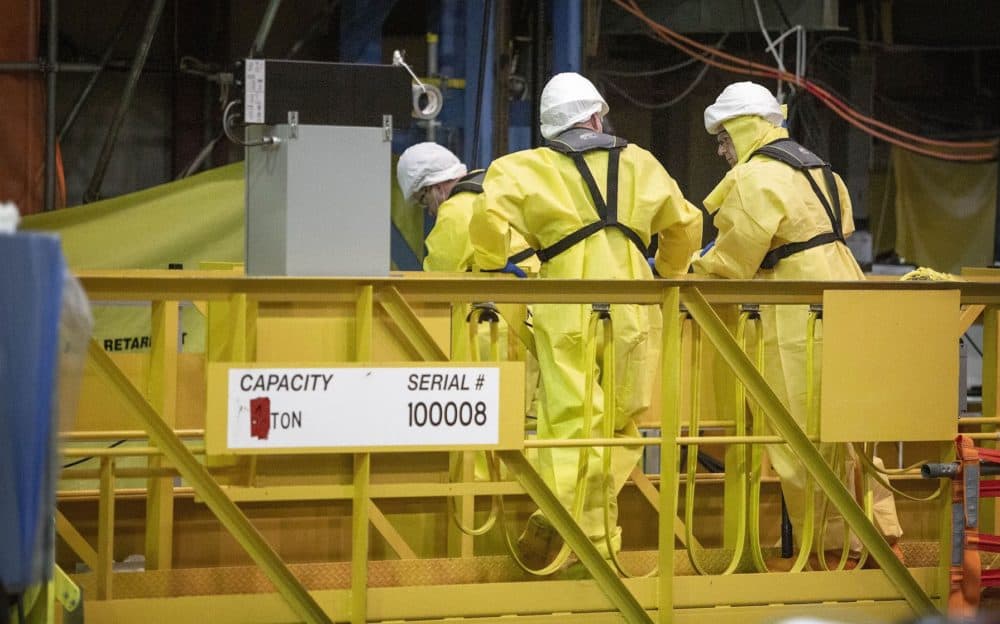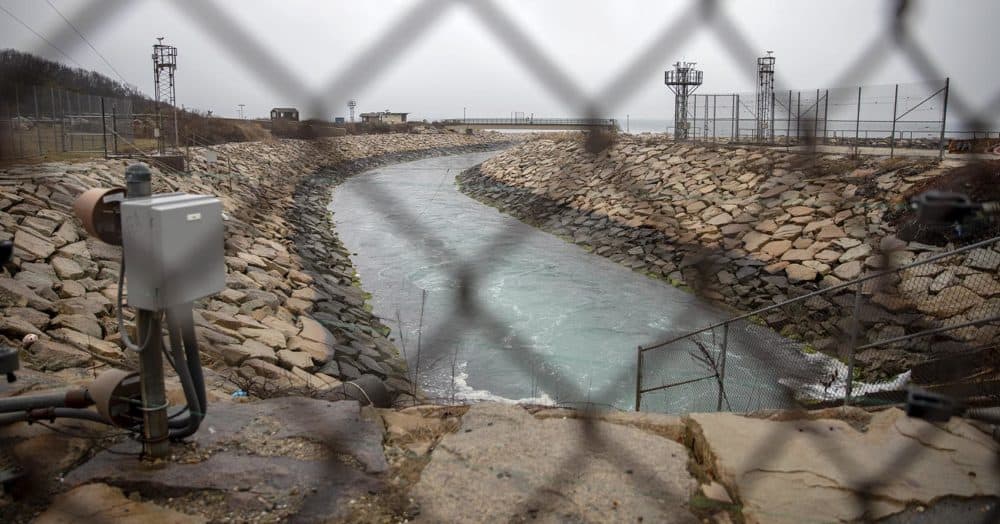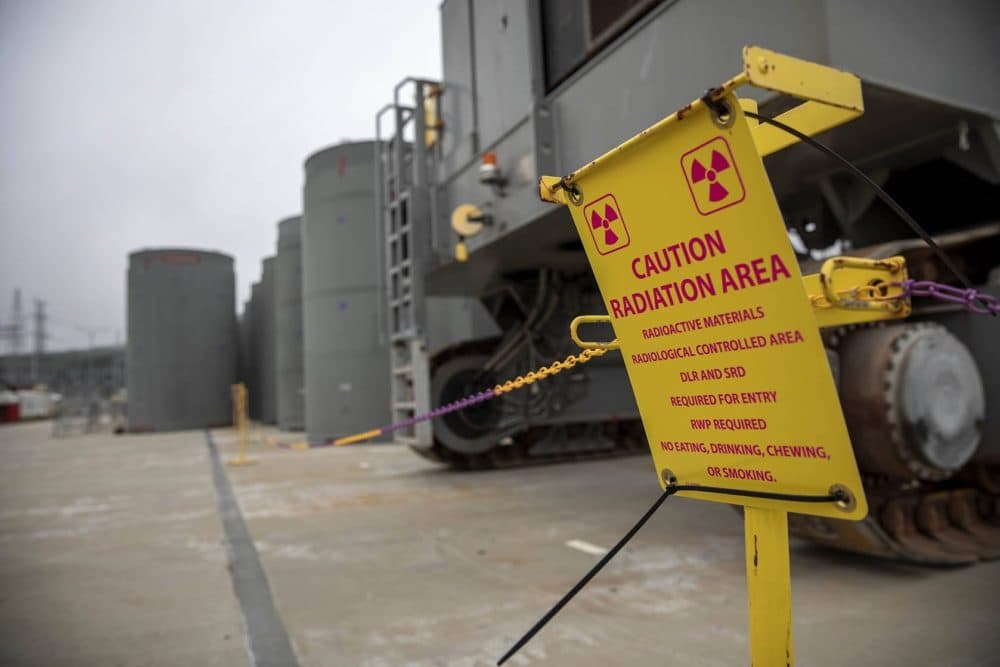Advertisement
State report details radioactive pollutants in Pilgrim wastewater

State data released this week offer the first detailed snapshot of the radioactive contaminants in wastewater stored at the Pilgrim Nuclear Power Plant in Plymouth.
Holtec, the company in charge of decommissioning Pilgrim, has proposed treating and diluting the approximately 1.1 million gallons of contaminated water and releasing it into Cape Cod Bay.
But the high levels of radiation in the wastewater have raised concerns that treating the water may not sufficiently reduce contamination to ease public worries.
Samples of one radioactive element, tritium, averaged about 100,000 becquerels per liter, about a million times higher than average background levels in the ocean. Another element, cesium, measured close to 400,000 becquerels per liter, about 200 million times higher than background levels in the North Atlantic.
These numbers reflect the radioactivity in untreated water, not the concentration that could be released into the bay, said Ann Scales, a spokesperson for the Massachusetts Department of Public Health, in an email.
"If a release were permitted, the water would have to meet concentration standards, be released slowly via batches, and be greatly diluted with Holtec’s seawater intake system prior to any discharge," she said.

But there is no commercially available treatment that can remove tritium from water. And while there are methods to remove other radioactive elements like cesium, they are not 100% effective.
"They've got a big job ahead," said Ken Buesseler, a marine radiochemist at the Woods Hole Oceanographic Institution who studies the distribution of radioactive elements in the ocean. "Not only do they have a big job ahead, they have to prove — after they've done it — that they've got that cesium down to something where we aren't concerned."
Even if treatment removed 99% of the cesium, he said, the resulting wastewater would still have levels 2 million times higher than what's in the ocean.
But that wastewater will then be diluted to safe levels, said Holtec Senior Compliance Manager David Noyes. The company intends to release the wastewater in 18,500-gallon batches, diluted with 3,000-12,0000 gallons of seawater per minute.
Advertisement
"The level of [radionuclides] — with the exception of tritium — will be extremely low, essentially at 'non-detect' levels, or slightly above," Noyes said. "This is not harmful to the ecosystem, and it's certainly not harmful to human beings."
A spokesman for the Nuclear Regulatory Commission, which oversees radioactive wastewater discharges from nuclear power plants, said that Pilgrim regularly discharged radioactive wastewater into Cape Cod Bay during its decades as an operating power plant.
"They were safe then. They'll be conducted safely now if they take place," said NRC spokesman Neil Sheehan.

But it's unclear if dilution will reduce radioactive contamination to levels that will allay public unease, said Buesseler. He also expressed concern about "clingy" elements like radioactive cobalt and cesium that could accumulate on the seafloor near the outflow pipe regardless of the dilution; and strontium, which can accumulate in the bones and shells of marine animals.
"What they really need to do is clean up first, and then make a radiological impact assessment," said Buesseler. "That really needs to be done prior to any decision being made, in my opinion, on a discharge into the ocean."
"Once you release them in the ocean, you will never get them back," he said.
Research published in 2022 by Woods Hole oceanographer Irina Rypina predicts that the plume of radiation discharged from Pilgrim would circulate through the bay and flow to the outer Cape. Rypina has now begun a more sophisticated modeling study to predict plume direction based on wind, weather and seasonal variability.
"Our job is just to provide the best available science so that sound decisions can be made," said Matt Charette, a senior scientist at the Woods Hole Oceanographic Institution, and director of WHOI's Sea Grant Program, which is funding the study.
A large contingent of residents, politicians, public health experts, environmentalists, business owners and fishing industry advocates continue to oppose any plans to dump the water in the bay.
Gregg Morris, owner of 2 Rock Oyster farm in Duxbury, called the proposal "mind-boggling" and said that even the perception of tainted water would harm the state's nearly $30 million dollar oyster industry.
"Would you want to eat something that's tainted? The perception is going to kill the market that we've developed," he said. "It's just sad, you know? This is my livelihood. This is how I support my family, how many of us support our families. And so it's just a real kick in the shins."
Holtec also announced this week that the cleanup of Pilgrim — including the dismantling of the reactor and the building surrounding it — will be delayed for four years, with expected completion in 2031. Holtec's David Noyes said the reason is mostly economic: high inflation, increased labor costs and a poor return on the trust fund set aside to pay for decommissioning. But Noyes also cited the ongoing uncertainty around the wastewater discharge as a factor in the delay.

"The first and most important job is to make sure that there's adequate money to be able to complete the job that we started, and we're not going to shortcut that," he said.
State Sen. Susan Moran, who represents the Plymouth and Barnstable area, has proposed a budget amendment to create an independent commission to investigate the ecological and economic impacts of discharging the wastewater into Cape Cod Bay. The amendment, which passed the Senate this week, would prohibit the state from approving any wastewater discharge permits for spent nuclear fuel pool water until the commission completes its report in 2025.
"We must fully understand the impact, both short term and long term, that these contaminants will have on our community moving forward," said Moran. She noted that Pilgrim is the first nuclear power plant to be decommissioned by Holtec, and will serve as a template for other plants across the country.
"This is a very important time to be sure that we do this right," she said.
A similar budget amendment was vetoed by Gov. Charlie Baker in 2022.
In a statement, the Healey administration expressed "serious concerns" about Holtec’s plan to discharge spent fuel pool water into Cape Cod Bay and that the governor "is monitoring this situation closely."
